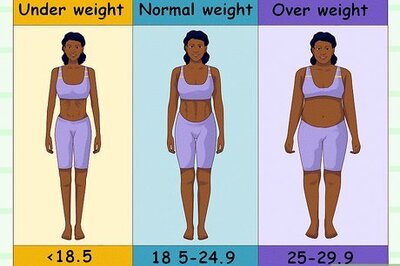
views
Can men be witches?
Yes, men can practice witchcraft and use the term “witch.” Many modern witches and practices acknowledge that men are and have always been accepted in witchcraft, even if the gender association of the word “witch” has changed over time. The word “witch” is actually gender-neutral and is an umbrella term for anyone who practices witchcraft or magic. It traces its roots back to the Old English words wicce (“a woman who practices witchcraft”) and wicca (“a man who practices witchcraft”). Over time, the gender-specific endings were dropped, and “witch” became the dominant form of the word for all genders. Although women are primarily associated with witches today, this wasn’t always the case. Take the Salem Witch Trials, for example: 6 men were killed or executed for being witches (along with 14 women). Similarly, from the 14th to 17th centuries in Europe, 20-25% of all those executed for witchcraft were male (and in some countries, like Iceland, men even made up a majority of accused witches). There’s also nothing about witchcraft itself that indicates women are the only practitioners. According to Ferris, witchcraft is “about becoming a co-creator of your life. Instead of seeing life as something that happens to you, it’s about aligning your will and desires with a larger cosmic force. It’s spiritual, but also practical—it brings intentionality to your emotions, thoughts, and actions.” Meet the wikiHow Expert Paige Ferris is an intuitive psychic, tarot reader, and astrologer with over 6 years of experience in practical occultism and psychological astrology.
Cultural movements led to the misconception that all witches are women. During the Middle Ages in Europe, it was believed that women were more easily seduced by the Devil’s temptation and would perform evil works on his behalf. The crimes witches were accused of—killing children, maiming pregnant women, making men impotent, spoiling cows and crops—were all related to a woman’s sphere of influence, deepening the connection between women and evil rituals and acts. By the 1600s, the word “witch” had become so associated with women that new terms like “he-witch” or “men-witches” were used to describe male witches. “Witch” also took on a misogynistic quality during this time, also coming to mean things like “ugly,” “old,” and “malignant.” Even today, people mistake neo-Pagan religions, like Wicca, as exclusively female. Although there are certain segments that are women-only (like Dianic Wicca), this doesn’t represent the majority of practices (even though this is the mainstream image of witchcraft).
Witch vs. Wizard
“Wizard” is popular in fiction and refers to wise men with magical abilities. “Wizard” comes from the Middle English wys (“wise”) and originally only meant “philosopher, sage, or person possessing great wisdom.” In the Middle Ages, when magic and philosophy were blurred together, it started to mean “one with magical power, one proficient in the occult sciences” and was generally used to refer to men. “Witch,” however, is gender-neutral and has always been used to describe those who practice magic. Some men may choose to call themselves wizards instead of witches, but generally, “wizard” is used more often in fictional works. “Sorcerer” is often used interchangeably with “wizard,” but sometimes implies a more innate magical ability (whereas wizards may acquire their skills through study). “Warlock” is a less common term meaning “one who deceives with magic” and is sometimes considered the male version of “witch.” It comes from the Old English wærloga (“traitor, liar, enemy, devil”).
How to Begin Witchcraft as a Man
Find a male witch mentor or role model for guidance and inspiration. The most visible practitioners of witchcraft today (in pop culture and online) are women, so it can feel intimidating or awkward to step into witchcraft as a man. A great first step is to follow and learn from some male witches, whether you read their books, watch their YouTube videos, listen to their podcasts, or follow them on social media. As Ferris says, “resources online are a big thing” for exploring the craft. Here are some resources from male witches to check out: Hilltop Farm Homestead on YouTube offers Wicca lessons and rituals (plus tutorials on herbs, gardening, cooking, and more). Southern Bramble: A Podcast of Crooked Ways is a podcast hosted by two queer male witches. BS Free Witchcraft is another podcast hosted by a non-binary witch. In some areas, you can also attend Pagan events to connect with practicing male witches in person. The best places to check are universities, local businesses like occult bookstores, or groups on apps like Meetup or Facebook. EXPERT TIP Paige Ferris Paige Ferris Tarot Reader, Astrologer, and Intuitive Psychic Paige Ferris is a Tarot Reader, Astrologer, and Intuitive Psychic based in Jackson County, MI. With over 6 years of experience, Paige is the founder of Catalyst Healer and specializes in practical occultism and psychological astrology. Paige offers astrology and tarot readings designed to empower her clients and help them achieve their goals. She provides 1:1 in-person and virtual readings to clients, appears at galas, expos, and other events, and shares readings and insights to her over 18k followers on social media. Paige Ferris Paige Ferris Tarot Reader, Astrologer, and Intuitive Psychic It’s really valuable to have mentors or guides. A good teacher will challenge your beliefs—that discomfort is often where growth happens. But, not all guidance will resonate right away. Be mindful of teachers who project their own perspectives. Use your intuition to detect when something doesn’t feel quite right.
Try a daily meditation practice to clarify your intentions. “I recommend meditation for beginner witches,” explains Ferris. “It helps you understand how your mind works and what belief systems you’re operating under. Focus on yourself—stabilize your emotions, learn how to observe emotional influxes without reacting to them, and learn what your inner narratives about yourself and life are before you try to alter anything. The clearer you are as an inner vessel, the more results you’ll see from your practices. A clouded judgment will always produce a clouded, not clear outcome.” “That self-awareness informs your path,” she continues. “For example, I’m very analytical, so I was drawn to tarot and astrology, which have more structure. Others may be drawn to more intuitive paths. The key is to figure out what resonates with you.” Take your time meditating and learning about yourself before you jump into any spellwork or rituals. “It’s more important to acknowledge the problem than it is to conjure up the solution,” Ferris advises.
Write or speak your intentions to set them into motion. An easy way to ease your way into witchcraft is to release your intentions from your mind and put them into the universe after meditating. “I personally am big on the use of setting mental, written, and spoken intentions. How you speak about your life and circumstances influences the reality of those things, so be mindful,” Ferris explains. For example: Say you have an intention to find a new job and want to use witchcraft to help. After meditating, you could journal about your wish. Include what you’re looking for and why, how this new job would improve your life, and what you hope to gain from it. This simple act aligns your internal thoughts with your external actions. Or, you could use positive affirmations to verbally align yourself with your goal. You might repeat “I am worthy of a new and fulfilling job” or “I have what it takes to find a job I love” to yourself each day to invoke co-creation with the universe.
Use elements from the physical world in small rituals to affirm your intentions. “I recommend and use fire, water, air, and earth to solidify intentions, combining the inner world with the external world,” Ferris explains. “For example, when I set the intention to clear my inner world, I will take showers and visualize the water cleansing the chaos inside my body. If I feel like I need protection, I will use a stone like black tourmaline to manifest a physical barrier to protect me from negative forces with earth itself.” She continues, “Fire is good for transforming or bringing motion, like lighting candles to honor a wish. Air helps with ideas and removing stagnant narratives, so going outside for a ‘breath of fresh air’ can confirm an intention.” Though these rituals are simple, they’re helpful ways to “apply your practices in everyday life,” says Ferris. Part of being a witch is learning to interact with the world in a new way!
Feel free to adjust gendered spells and rituals to fit your identity. If you end up joining a practice or religion like Wicca, you may come across rituals with gendered language that’s female-focused. Often, the words of these rituals are not set in stone, so you can change phrases like “I am a daughter of the Goddess” to “I am a son of the Goddess” or “I am a child of the Goddess.” As long as the adjustments align with your feelings and intentions, then it’s OK! There are some exceptions to this. For example, a ritual honoring mothers should stay focused on the divine feminine and motherhood, only changing a few words as they pertain to your personal gender or sex.
Keep your focus on your intentions and energy, not outcomes. As Ferris puts it, the bottom line of starting witchcraft is to “learn to co-create. Don’t try to force outcomes, but don’t be passive and expect things to fall into your lap. Work together with the energies presented in front of you, and it can suddenly lead you to where you want to be.”
What can men gain from witchcraft?
Men can gain better introspection, emotional regulation, and spiritual balance from witchcraft. Witchcraft’s focus on meditation and setting intentions can facilitate introspection and self-reflection, leading to a deeper connection with your emotions. This is especially relevant for men today, many of whom are taught to remain stoic or “unbothered” when it comes to dealing with feelings (potentially leading to angry outbursts and strained relationships as a result). Some practices, like Wicca, emphasize both the divine feminine and the divine masculine, allowing male practitioners to connect with different facets of their feelings and identity. Many male witches report that this attunement to their spiritual energy has helped them improve themselves and become more supportive family and community members.
Famous Male Witches from History
Gerald Gardner (1884–1964) Known as the “father of modern witchcraft,” Gardner played a significant role in the revival (and popularization) of witchcraft in the 20th century and was a leading figure in the creation of the neo-Pagan religion Wicca. He wrote the Book of Shadows, a text containing numerous spells and rituals that has become foundational for many practicing Wiccans. Many Wiccan traditions and covens today trace their roots directly back to Gardner's teachings and writings.
Aleister Crowley (1875–1947) Crowley was an English occultist and writer who created a polarizing name for himself in the early 20th century. Most significantly, he established the religious movement called Thelema, based on an experience he (supposedly) had in Cairo, Egypt in 1904, when a deity called Aiwass shared The Book of the Law with him. This experience became the foundation for Thelema practices. Crowley also wrote many books about mysticism, magic, and Eastern occult practices. His most well-known works include The Book of Lies, The Book of Thoth, and Magick.
John Dee (1527–1608) Dee was a mathematician by training who served as a consultant and astrologer to Queen Mary I and scientific advisor to Queen Elizabeth I. He believed math and science were facets of the divine and insisted that a single mathematical-magical symbol was the key to unlocking the unity of nature. He was known to host séances to converse with angels to further his work, and toured continental Europe to spread his occult ideas.


















Comments
0 comment